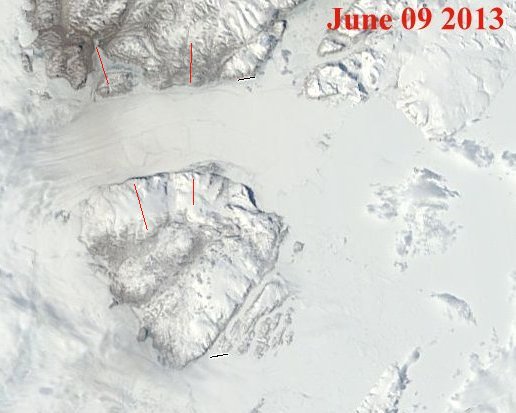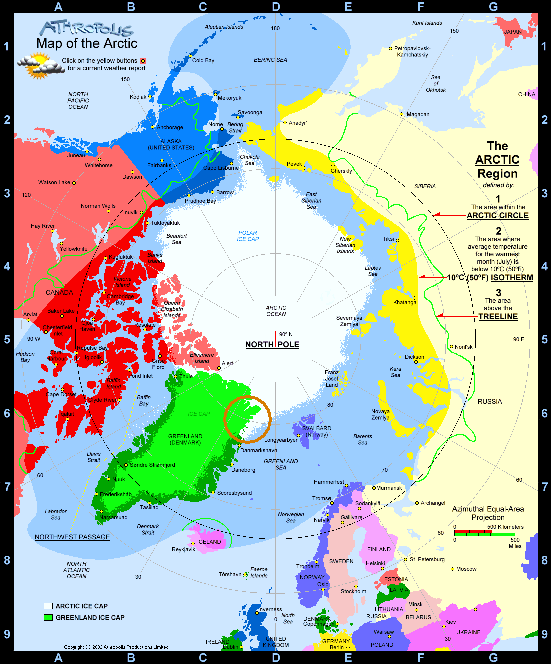Substantial cracks in the Nioghalvfjerdsfjorden glacier ice tongue appear to be growing in extent and number. While not as spectacular as the 2010 calving of the Peterman Ice Island, it is more closely linked to global warming than
Otherwise known as 79 North, Nioghalvfjerdsfjorden glacier is a floating outlet glacier, about 60 km long and 20 km wide located at 79°30'N, 22° W, draining a large area of the northeast Greenland ice sheet.

Recently observed cracks in the Nioghalvfjerdsfjorden floating glacier tongue.
Global warming was predicted to be most prominent in the polar regions, and most especially the Arctic. Among the impacts of a warming Arctic it was predicted that the effects on Greenland's ice sheet and glaciers would be very pronounced in the North East.
The land fast ice in the area of Zachariae and Nioghalvfjerdsfjorden glaciers is normally cyclic. Despite its growth and decay it tends to buttress the glaciers and slow down the rate of calving. Since the year 2000 the landfast ice which has melted in the summer has not formed a thick and robust replacement in the winter. Consequently, the sea ice's tendency to slow glacier calving has been greatly reduced over the years.
As an ice tongue rises and falls with the tide, obviously, there is more water under it at high tide. That extra water ebbs and flows with the tide, tending to bring in warm sea water and to carry away heat. Any meltwater coming from under the ice will tend to oppose the incoming tidal water, but it too will tend to carry away heat. The loss of the Odden, which has not formed since 1997 ; the failure of sea ice to regenerate a shelf of strong landfast ice; the decline in Arctic sea ice volume; the inexorable poleward march of the marginal ice zone and loss of the great ice barrier: all of these are clear signs of warming. Warmer waters penetrating under an ice tongue will predictably promote basal melt. Thinner ice will be more prone to crack as it flexes due to the tidal current underneath it. The animation below highlights some of these cracks.

Animation of cracks in the Nioghalvfjerdsfjorden floating glacier tongue.
Of recent years the Zachariae Ice Stream, or ZIS, has been studied in some detail. The terminus is retreating.
The reduced sea ice in the region has exposed the ZIS terminus to increased open water in what was typically a region that was dominated by persistent sea ice. The enhanced surface melting is also a concern. In 2012 ZIS has experienced an additional retreat that has separated the main glacier from a melange of glacier ice and fast sea ice on the northeast side of the terminus, that had survived the last major tongue disintegration of the southern floating arm of ZIS in 2000-2001. The changes have been an going watch by several of the participants at the Arctic Sea Ice blog, which has developed into a wonderful community for daily detailed sea ice observations.
Mauri Pelto
The shelf ice in this region has deteriorated in each year from year 2000 to present. Large shelf ice break-offs such of this magnitude are becoming increasingly common in the Northeast region. Over the past 8 melt seasons there have been cases of significant shelf ice loss greater than 1700 km^2 on a year by year basis. Comparing the images on 4 July and 6 July we have an area deformation of 2970km^2. In relation to Columbus, Oh, this glacier change would fit into the metropolitan area of Columbus twice.
Jason Box, 2008
... In the north of Greenland, the dominant form of mass loss is basal melting at the underside of floating ice shelves.
2) Basal melt rates inferred from steady state conditions average 5-8 m/yr, but reach 20 m/yr in the first 10 km of floating ice. These rates are one order of magnitude or two larger than those inferred for the large ice shelves in Antarctica, and in the higher end of the spectrum of model calculations.
3) Overall, the northern part of the Greenland Ice Sheet is not grossly out of balance, but probably thinning. Thinning is indicated from its slightly negative
mass budget at the grounding line, and by the systematic retreat of its grounding lines, except in the case of surge-type glaciers in
a quiescent phase. The advantage of measuring grounding line retreat over other methods is that it is not dependent on accumulation and ablation.
4) The mass budget of the large glaciers (Petermann, Niohalvfjerdbrae and Zachariae Isstrom) is more strongly into the negative. Ice thinning is not likely to
be due to an increase in summer melt alone. Glacier thinning must include a dynamic component as well. This is consistent with the concept of enhanced
thinning in areas of concentrated flow. This trend is emphasized at lower latitudes, e.g. along the east coast of Greenland.
PARCA report
It seems highly unlikely that the NE Greenland warming trend will reverse. With continued warming the 79 North glacier tongue is likely to break up over the next few years, into ever smaller pieces, until those pieces can flow unobstructed into Fram Strait. Meanwhile the Zachariae terminus will continue its retreat.
Edit - added map below to show - ringed - area of interest. Source athropolis.com.

.




Comments